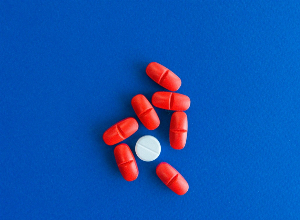What are the potential health risks of acetaminophen?
Published Apr 4, 2022 • By Courtney Johnson
More commonly known in the United States under the brand name Tylenol®, acetaminophen is the most widely used analgesic worldwide. It is found in more than 600 different medicines, ranging from prescription to over the counter (OTC), and is estimated to be used by 23% of American adults each week.
So, what is acetaminophen exactly? How does it work? How and when can it pose a risk to our health?
We explain it all in our article!

What is acetaminophen?
Whether it’s in your medicine cabinet, the middle console in your car, or in your desk at work, chances are that you have acetaminophen close at hand, in the case that a headache or joint pain strikes. Not only is acetaminophen the most widely used pain reliever in the United States, it is the most used worldwide, and is also considered one of the safest.
Acetaminophen, also known as paracetamol or APAP (N-acetyl-para-aminophenol), is a drug used to relieve mild to moderate pain and reduce fever. It is an ingredient in over 600 prescription and OTC medications, such as Tylenol®, Nyquil®, Excedrin®, and Vicodin®.
Because of its dual action, it can be used to treat many ailments, including headache, muscle pain, backache, toothache, menstrual cramps, cold, sore throat, and arthritis.
How does acetaminophen work?
Acetaminophen’s exact mechanism of action is still not fully understood.
Acetaminophen belongs to a class of painkillers called non-opioid analgesics, which includes aspirin, traditional non-steroidal anti-inflammatory drugs (NSAIDs) like ibuprofen and naproxen, and the newer COX-2 inhibitors like celecoxib (Celebrex®).
Non-opioid analgesics function by blocking an enzyme called cyclooxygenase (COX). COX acts as a trigger for the conversion of a fatty acid contained in cell walls (arachidonic acid) into substances known as prostaglandins. Prostaglandins have many roles in the human body, but they can also cause inflammation, pain, and fever. The pain and inflammation they cause occurs after cell injury, primarily at the site of the injury in the peripheral nervous system (outside the brain and spinal cord) and in the central nervous system. They also elevate body temperature, therefore creating fever, by impacting the heat regulating center of the hypothalamus in the brain.
By inhibiting COX and the production of prostaglandins, non-opioid analgesics reduce both inflammation and fever. Acetaminophen, though, is different from other non-opioid analgesics in that it does not block COX in the peripheral nervous system to a significant extent. It seems to reduce pain by inhibiting a form of COX called COX-3, though more research is needed to understand this process.
The bottom line: While acetaminophen does a great job easing minor aches and pains such as headache and fever, it cannot reduce swelling or inflammation.
Which medicines contain acetaminophen?
As mentioned previously, acetaminophen is the most common analgesic in the United States and is present in over 600 medications, available both on prescription and over the counter.
Over-the-counter medications containing acetaminophen*:
- Actifed ®
- Alka-Seltzer Plus Liquid Gels®
- Anacin®
- Benadryl®
- Cepacol®
- Dayquil®
- Excedrin®
- Feverall®
- Goody’s®
- Midol®
- Nyquil®
- Panadol®
- Robitussin®
- Saint Joseph®
- Sudafed®
- Theraflu®
- Tylenol® brand products
- Vicks®
- Zicam®
- **And store brands
Prescription medicines containing acetaminophen*:
- Endocet®
- Fioricet®
- Hydrocet®
- Hydrocodone Bitartrate®
- Lortab®
- Percocet®
- Phenaphen®
- Tylenol® with Codeine
- Ultracet®
- Vicodin®
- Zydone®
- ***And generic medicines
*Neither of these lists is exhaustive, make sure to check your prescription and OTC drug labels and/or consult your doctor or pharmacist before taking.
What are the side effects or other risks caused by acetaminophen?
When used properly with the recommended doses, acetaminophen is viewed as one of the safest OTC medications. Unlike other NSAIDs, it does not irritate the stomach or intestinal lining or increase risk of heart problems, making it a good alternative for people who cannot tolerate NSAIDs.
But, as with all medications, certain side effects and risks are still possible.
Though uncommon, side effects of acetaminophen may include:
- Headache
- Nausea
- Stomach pain
- Rash
Occasionally, it may cause more serious side effects, such as severe allergic or skin reactions. Large doses of acetaminophen can provoke stomach cramps and nausea in first instance, and as physical conditions deteriorate, it can cause liver injury, failure, and even death.
Liver damage
Liver damage is the most serious side effect of acetaminophen use and can be fatal. It can occur when a person exceeds the maximum daily dose of 4,000 mg (the maximum dosage is 60 mg/kg/day, divided into 4 or 6 doses, i.e. approximately 15 mg/kg every 6 hours) but has also been known to occur in certain patients at lower doses. It can happen after one, very large dose of the drug, or after higher-than-recommended doses every day for several days.
When we take acetaminophen, most of the drug is metabolized by the liver and excreted through urination. However, some of the drug is also converted into a toxic byproduct that can harm liver cells. Taking too much acetaminophen raises the risk of liver damage, and in severe cases, can lead to death.
Because acetaminophen is a common ingredient in such a broad range of prescription and OTC drugs, it can unfortunately be rather easy to accidentally take too much, especially if you’re taking more than one acetaminophen-containing medicine at once.
Signs of liver damage can include:
- Yellowing of the skin or whites of the eyes (jaundice)
- Nausea or vomiting
- Loss of appetite
- Pain in the upper right abdomen
- Fatigue
- Excessive sweating
- Pale skin
- Unusual bleeding or bruising
- Changes in the color of urine or stool
If you suspect you’ve taken too much acetaminophen or notice any symptoms, contact your local poison control center or seek medical help immediately. If you know you’ve taken more than the recommended dose, go to your nearest emergency care center, even if you don’t have any symptoms of liver damage.
How to prevent overuse or overdose of acetaminophen?
If you ever have concerns about how much acetaminophen your body can tolerate based on your age, body size, and health status, don’t hesitate to talk to your doctor or pharmacist.
Here are a few helpful tips for avoiding an accidental overdose:
- Track what you take, including over the counter remedies: When you reach for an over-the-counter headache, cold, or flue product, don’t forget to check the label. Does it contain acetaminophen? Note that on prescription drug labels, acetaminophen is sometimes listed as “APAP,” “acetam,” or other shortened forms of the word.
- Know the milligram doses of your pills: In acetaminophen-containing products available over the counter, pills may contain 325, 500, or 650 milligrams of the drug. Be aware of what you’re taking and make sure to calculate how much you’re taking in a 24-hour period. Take extra caution with 500 or 650 mg pills.
- Follow the recommended dosage guidelines: When taking acetaminophen, don’t be tempted to take more than is recommended to get an extra effect. It is recommended that small-bodied people stay on the low end of the recommended range (3,000 mg per 24-hour period).
- Go easy on the alcohol: Consuming alcohol causes the liver to metabolize more of the acetaminophen you take into toxic byproducts. Men should not drink more than two standard drinks per day when taking acetaminophen and women should not have more than one standard drink.
- Know if your medications can interact: Make sure to be aware of your prescription medications and ask your doctor or pharmacist if any of them could interact with acetaminophen.
Was this article helpful to you?
Give it a like and share your thoughts and questions with the community in the comments below!
Take care!
Sources:
Acetaminophen, MedlinePlus – NIH National Library of Medicine
Acetaminophen safety: Be cautious but not afraid, Harvard Health Publishing
Tylenol Side Effects, drugwatch
Acetaminophen: Is it as safe as we think?, MedicalNewsToday
Side Effects of Acetaminophen (Tylenol), Healthline
Acetaminophen, Consumer Healthcare Products Association
Common Medicines with Acetaminophen, Acetaminophen Awareness Coalition
How does acetaminophen relieve pain? Tufts Journal
1 comment
You will also like

Spoon theory: What is it and how can it help people living with chronic illness?
Apr 13, 2022 • 7 comments

What is the psychological impact of chronic pain? Carenity members share their experience!
May 27, 2021 • 8 comments

 Facebook
Facebook Twitter
Twitter

